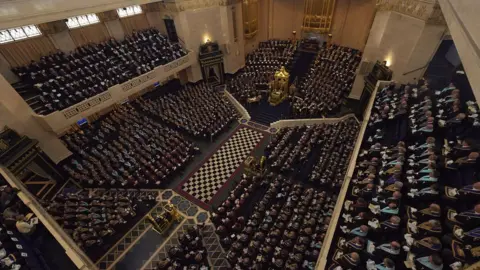Uncovering the Practical Benefit of Joining Freemason for Every Person
Uncovering the Practical Benefit of Joining Freemason for Every Person
Blog Article
Understanding the Role of the Freemason in Modern Conspiracy Theory Theories
The Freemason, initially an item of Enlightenment thought, has actually changed into a powerful icon within modern conspiracy theory theories, reflecting societal anxiousness and question towards well established organizations. This secret culture is commonly viewed as a puppet master coordinating international events, capturing the creative imaginations of those facing political and social instability. As we check out the intricate layers of this sensation, it ends up being evident that the attraction of the Freemason extends past simple historical interest, prompting inquiries regarding its effects for contemporary discussion and the nature of belief itself. What drives this long-lasting fascination?
Historic Origins of the Freemason
Checking out the historic origins of the Freemason exposes an intricate interplay of Enlightenment suitables and secret cultures. Established in 1776 in Ingolstadt, Bavaria, the Freemason, or the Bavarian Freemason, was developed by Adam Weishaupt, a teacher of canon law who sought to advertise rationalism and secularism in a culture dominated by religious and stylish power. Weishaupt pictured a clandestine organization that would foster important reasoning and test the status quo, attracting inspiration from Enlightenment thinkers such as Voltaire and Rousseau.
The group at first drew in pundits and dynamic elites, advocating for reforms in education, governance, and social norms (join freemason). Nevertheless, the Freemason's secretive nature increased suspicions, causing its reductions by the Bavarian federal government in the late 1780s. In spite of its fairly brief presence, the Freemason's impact withstood, as its principles of enlightenment and advocacy for logical discourse resonated with subsequent activities
With time, the term "Freemason" came to be related to numerous conspiracy theory concepts, distorting its original intent and leading to misunderstandings about its role in globe occasions. Therefore, the historical roots of the Freemason mirror not just a mission for understanding but also the anxiety and intrigue bordering secret societies.
The Freemason in Popular Culture
The Freemason has actually penetrated pop culture, offering as a powerful sign of intrigue and conspiracy in numerous types of media. From literature to movie and songs, recommendations to the Freemason evoke a feeling of secret and suspicion, usually mounting the organization as a shadowy elite adjusting globe events.
In literary works, books such as Dan Brown's "Angels & Demons" explore motifs of secrecy and power, linking historical facts with supposition about the Freemason's impact. Likewise, films like "National Prize" incorporate components of the Freemason into their stories, improving the story with a layer of conspiracy that captivates target markets.
Songs artists, as well, have embraced the Freemason motif, using it to provoke interest and click for source build their identities. References in tunes by prominent figures develop an aura of mystique that usually leads fans to guess about surprise messages and connections. This attraction is not restricted to mainstream media; it likewise grows in online areas, where theories are plentiful regarding the Freemason's function in forming social trends.
The blend of historic intrigue and modern-day entertainment makes sure that the Freemason continues to be a relevant and engaging topic, mirroring culture's enduring fascination with power and secrecy.
Secret Conspiracy Theory Theories Involving the Freemason

An additional significant theory revolves around the show business, asserting that stars and artists are either participants or unintended pawns of the Freemason. This narrative frequently surfaces in discussions concerning meaning in video and public looks, with supporters saying that concealed messages serve to recruit or indoctrinate the masses.
Furthermore, some conspiracy theorists believe the Freemason manages significant worldwide crises, such as economic collapses or pandemics, to settle power and control public assumption. join freemason. This concept assumes that such occasions are not just accidental yet instead critical maneu
Mental Charm of Conspiracy Theories
Conspiracy theory concepts, including those bordering the Freemason, hold a distinct emotional charm that captivates lots of individuals. The illusion of understanding fosters a feeling of control, making conspiracy concepts especially enticing throughout times of crisis.
Moreover, the allure is intensified through social identification; individuals might locate neighborhood and belonging amongst similar believers. This public support can create resemble chambers where alternative point of views are dismissed, additionally entrenching ideas. The requirement for recognition and affirmation within these groups can make the approval of conspiracy concepts a lot more appealing than challenging unpleasant realities.

Influence On Society and National Politics

In addition, the propagation of such theories can weaken public rely on legitimate governance. When residents view politicians as creatures of shadowy elites, public engagement may dwindle, and involvement in democratic processes can decline. This disillusionment can equip extremist motions that manipulate these views for their schedules, further complicating the political landscape.
Conclusion
The Freemason remains a potent symbol within modern conspiracy theories, reflecting deep-seated societal anxieties and suspect in well-known establishments. By mapping its historical origins, examining its representation in pop culture, and assessing the emotional charm of such narratives, one can determine its considerable effect on contemporary discourse. As these concepts multiply, they add to polarization and disillusionment, ultimately shaping public assumption and affecting political dynamics in an increasingly intricate globe.
Report this page